 |
Search the Site with

|
USS Hancock (CV 19)
- formerly TICONDEROGA -- later CVA 19 -
- decommissioned -
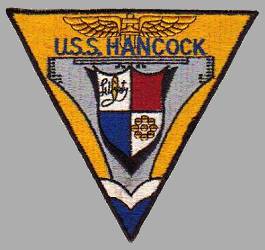 | 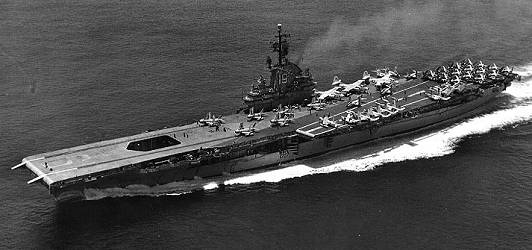 |
USS HANCOCK was one of the ESSEX - class aircraft carriers. Originally named TICONDEROGA, the carrier was renamed HANCOCK on May 1, 1943, becoming the fourth ship in the Navy to bear the name. In the mid 1950s, the HANCOCK was the first carrier of the United States Fleet with steam catapults capable of launching high performance jets. Redesignated as attack aircraft carrier CVA 19 on October 1, 1952, and multi-purpose aircraft carrier CV 19 on June 30, 1975, the HANCOCK was decommissioned on January 30, 1976, and stricken from the Navy list the following day. She was sold for scrap by the Defense Reutilization and Marketing Service (DRMS) on September 1, 1976.
| General Characteristics: | Awarded: 1940 |
| Keel laid: January 26, 1943 | |
| Launched: January 24, 1944 | |
| Commissioned: April 15, 1944 | |
| Decommissioned: May 9, 1947 | |
| Recommissioned: February 15, 1954 | |
| Decommissioned: January 30, 1976 | |
| Builder: Bethlehem Steel Co., Quincy, Mass. | |
| Propulsion system: 8 boilers | |
| Propellers: four | |
| Aircraft elevators: three | |
| Arresting gear cables: four | |
| Catapults: two | |
| Length: 888.5 feet (270.8 meters) | |
| Flight Deck Width: 191.9 feet (58.5 meters) | |
| Beam: 101 feet (30.8 meters) | |
| Draft: 30.8 feet (9.4 meters) | |
| Displacement: approx. 44,700 tons full load | |
| Speed: 33 knots | |
| Planes: 80-100 planes | |
| Crew: approx. 3448 | |
| Armament: see down below |
Crew List:
This section contains the names of sailors who served aboard USS HANCOCK. It is no official listing but contains the names of sailors who submitted their information.
- Click here to view the list.
- Click here
to see which USS HANCOCK memorabilia are currently for sale on ebay.
USS HANCOCK Cruise Books:
- World War II Cruise Book 1944 - 45
- World War II Cruise Book 1945 (Air Group 6 Cruise Book)
- WestPac Cruise Book 1955 - 56
- WestPac Cruise Book 1957
- WestPac Cruise Book 1958
- WestPac Cruise Book 1960 - 61
- WestPac Cruise Book 1962
- WestPac Cruise Book 1963
- WestPac Cruise Book 1964 - 65
- WestPac Cruise Book 1965 - 66
- WestPac Cruise Book 1967
- WestPac Cruise Book 1968 - 69
- WestPac Cruise Book 1969 - 70
- WestPac Cruise Book 1970 - 71
- WestPac Cartoon Cruise Book 1970 - 71
- WestPac Cruise Book 1972
- WestPac Cruise Book 1973 - 74
- WestPac Cruise Book 1975
About the different armament:
- 1945: 12 5-inch (12.7 cm) 38 caliber guns, 72 40mm guns and 59 20mm guns
- 1954: 8 5-inch (12.7 cm) 38 caliber guns and 28 3-inch (7.6 cm) 50 caliber guns, Regulus I missiles
- 1957: 8 5-inch (12.7 cm) 38 caliber guns and 8 3-inch (7.6 cm) 50 caliber guns
- 1959: 8 5-inch (12.7 cm) 38 caliber guns
- 1975: 4 5-inch (12.7 cm) 38 caliber guns
Accidents aboard USS HANCOCK:
| Date | Where | Events | |||
|---|---|---|---|---|---|
| November 25, 1944 | off the Philippines | A kamikaze aircraft attempting to crash into the USS HANCOCK is exploded by anti-aircraft fire some 300 feet above the carrier but a section of the plane's fuselage lands amidships and a part of the wing hits the flight deck and bursts into flames. Prompt and skillful teamwork quickly extinguish the blaze and prevent serious damage. | |||
| January 21, 1945 | off Formosa | One of USS HANCOCK's planes returning from a sortie makes a normal landing, taxies to a point abreast of the island, and disintegrates in a blinding explosion killing 50 men and injuring 75 others. Damage control work quickly brings the fires under control in time to land other planes which were still aloft. HANCOCK returns to formation and launches strikes against Okinawa the next morning. | |||
| April 7, 1945 | west of Okinawa | A suicide plane cartwheels across USS HANCOCK's flight deck and crashes into a group of planes while its bomb hits the port catapult to cause a tremendous explosion. Although 62 men were killed and 71 wounded, skilled efforts doused the fires within half an hour enabling HANCOCK to be back in action before an hour had passed.
| |||
| January 31, 1958 | An aircraft explodes on the flight deck of USS HANCOCK killing two. | ||||
| November 26, 1968 | off South Vietnam | USS HANCOCK and the USS CAMDEN (AOE 2) collide during an underway replenishment. There are no injuries but the CAMDEN is slightly damaged. |
History of USS HANCOCK:
USS HANCOCK was laid down as TICONDEROGA 26 January 1943 by the Bethlehem Steel Co., Quincy, Mass.; renamed HANCOCK 1 May 1943, launched 24 January 1944; sponsored by Mrs. DeWitt C. Ramsey, wife of Rear Adm. Ramsey, Chief of the Bureau of Aeronautics; and commissioned 15 April 1944, Captain Fred C. Dickey in command.
After fitting out in the Boston Navy Yard and shake-down training off Trinidad and Venezuela, HANCOCK returned to Boston for alterations 9 July. She departed Boston 31 July 1944 en route to Pearl Harbor via the Panama Canal and San Diego, and from there sailed 24 September to join Adm. W. F. Halsey's Third Fleet at Ulithi 5 October. She was assigned to Rear Adm. Bogan's Carrier Task Group 38.2.
HANCOCK got underway the following afternoon for a rendezvous point 375 miles west of the Marianas where units of Vice Adm. Mitscher's Fast Carrier Task Force 38 were assembling in preparation for the daring cruise to raid Japanese air and sea bases in the Ryukyus, Formosa, and the Philippines. Thus enemy air power was paralyzed during General MacArthur's invasion of Leyte. When the armada arrived off the Ryukyu Islands 10 October 1944, HANCOCK's planes rose off her deck to wreak destruction upon Okinawan airfields and shipping. Her planes destroyed seven enemy aircraft on the ground and assisted in the destruction of a submarine tender, 12 torpedo boats, two midget submarines, four cargo ships, and a number of sampans. Next on the agenda were Formosan air bases where 12 October HANCOCK's pilots downed six enemy planes and destroyed nine more on the ground. She also reported one cargo ship definitely sunk, three probably destroyed, and several others damaged.
As they repelled an enemy air raid that evening, HANCOCK's gunners accounted for a Japanese plane and drove countless others off during seven hours of uninterrupted general quarters. The following morning her planes resumed their assault, knocking out ammunition dumps, hangars, barracks, and industrial plants ashore and damaging an enemy transport. As Japanese planes again attacked the Americans during their second night off Formosa, HANCOCK's anti-aircraft fire brought down another raider which splashed about 500 yards off her flight deck. On the morning of the third day of operations against this enemy stronghold, HANCOCK lashed out again at airfields and shipping before retiring to the southeast with her task force. As the American ships withdrew, a heavy force of Japanese aircraft roared in for a parting crack. One dropped a bomb off HANCOCK's port bow a few seconds before the carrier's guns splashed the attacker into the sea. Another bomb penetrated a gun platform but exploded harmlessly in the water. The surviving attackers then turned tail, and the task force was thereafter unmolested as they sailed toward the Philippines to support the landings at Leyte.
On 18 October 1944, she launched planes against airfields and shipping at Laoag, Aparri, and Camiguin Island in Northern Luzon. Her planes struck the islands of Cebu, Panay, Negros, and Masbate, pounding enemy airfields and shipping. The next day she retired toward Ulithi with Vice Admiral John S. McCain's Carrier Task Group 38.1.
She received orders 23 October to turn back to the area off Samar to assist in the search for units of the Japanese fleet reportedly closing Leyte to challenge the American fleet and to destroy amphibious forces which were struggling to take the island from Japan. HANCOCK did not reach Samar in time to assist the heroic escort carriers and destroyers of "Taffy 3" during the main action of the Battle off Samar but her planes did manage to lash the fleeing Japanese Center Force as it passed through the San Bernardino Straits. HANCOCK then rejoined Rear Adm. Bogan's Task Group with which she struck airfields and shipping in the vicinity of Manila 29 October 1944. During operations through 19 November, her planes gave direct support to advancing Army troops and attacked Japanese shipping over a 350-mile area. She became flagship of Fast Carrier Task Force 38, 17 November 1944 when Vice Adm. McCain came on board.
Unfavorable weather prevented operations until 25 November when an enemy aircraft roared toward HANCOCK in a suicide dive out of the sun. Anti-aircraft fire exploded the plane some 300 feet above the ship but a section of its fuselage landed amidships and a part of the wing hit the flight deck and burst into flames. Prompt and skillful teamwork quickly extinguished the blaze and prevented serious damage.
HANCOCK returned to Ulithi 27 November 1944 and departed from that island with her task group to maintain air patrol over enemy airfields on Luzon to prevent enemy suicide attacks on amphibious vessels of the landing force in Mindoro. The first strikes were launched 14 December against Clark and Angeles Airfields as well as enemy ground targets on Salvador Island. The next day her planes struck installations at Masinloc, San Fernando, and Cabatuan, while fighter patrols kept the Japanese airmen down. Her planes also attacked shipping in Manila Bay.
HANCOCK encountered a severe typhoon 17 December and rode out the storm in waves which broke over her flight deck, some 55 feet above her waterline. She put into Ulithi 24 December and got underway six days later to attack airfields and shipping around the South China Sea. Her planes struck hard blows at Luzon airfields 7 and 8 January 1945 and turned their attention back to Formosa 9 January hitting fiercely at airfields and the Tokyo Seaplane Station. An enemy convoy north of Camranh Bay, Indochina, was the next victim with two ships sunk and 11 damaged. That afternoon HANCOCK launched strikes against airfields at Saigon and shipping on the northeastern bulge of French Indochina. Strikes by the fast and mobile carrier force continued through 16 January, hitting Hainan Island in the Gulf of Tonkin, the Pescadores Islands, and shipping in the harbor of Hong Kong. Raids against Formosa were resumed 20 January 1945. The next afternoon one of her planes returning from a sortie made a normal landing, taxied to a point abreast of the island, and disintegrated in a blinding explosion which killed 50 men and injured 75 others. Again outstanding work quickly brought the fires under control in time to land other planes which were still aloft. She returned to formation and launched strikes against Okinawa the next morning.
HANCOCK reached Ulithi 25 January 1945 where Vice Adm. McCain left the ship and relinquished command of the 5th Fleet. She sortied with the ships of her task group 10 February and launched strikes against airfields in the vicinity of Tokyo 16 February. During that day her air group downed 71 enemy planes, and accounted for 12 more the next. Her planes hit the enemy naval bases at Chichi Jima and Haha Jima 19 February. These raids were conducted to isolate Iwo Jima from air and sea support when Marines hit the beaches of that island to begin one of the most bloody and fierce campaigns of the war. HANCOCK took station off this island to provide tactical support through 22 February, hitting enemy airfields and strafing Japanese troops ashore.
Returning to waters off the enemy home islands, HANCOCK launched her planes against targets on northern Honshu, making a diversionary raid on the Nansei-shoto islands 1 March before returning to Ulithi 4 March.
Back in Japanese waters HANCOCK joined other carriers in strikes against Kyushu airfields, southwestern Honshu and shipping in the Inland Sea of Japan, 18 March 1945. HANCOCK was refueling the destroyer USS HALSEY POWELL (DD 686) on 20 March when suicide planes attacked the task force. One plane dove for the two ships but was disintegrated by gunfire when about 700 feet overhead. Fragments of the plane hit Hancock's deck while its engine and bomb crashed the fantail of the destroyer. HANCOCK's gunners shot down another plane as it neared the release point of its bombing run on the carrier. HANCOCK was reassigned to Carrier Task Group 58.3 with which she struck the Nansei-shoto islands 23 through 27 March and Minami Daito Jima and Kyushu at the end of the month.
When the 10th Army landed on the western coast of Okinawa 1 April HANCOCK was on hand to provide close air support. A suicide plane cartwheeled across her flight deck 7 April and crashed into a group of planes while its bomb hit the port catapult to cause a tremendous explosion. Although 62 men were killed and 71 wounded, heroic efforts doused the fires within half an hour enabling her to be back in action before an hour had passed.
HANCOCK was detached from her task group 9 April 1945 and steamed to Pearl Harbor for repairs. She sailed back into action 13 June and left lethal calling cards at Wake Island 20 June en route to the Philippines. HANCOCK sailed from San Pedro Bay with the other carriers 1 July and attacked Tokyo airfields 10 July. She continued to operate in Japanese waters until she received confirmation of Japan's capitulation 15 August 1945 when she recalled her planes from their deadly missions before they reached their targets. However planes of her photo division were attacked by seven enemy aircraft over Sagami Wan. Three were shot down and a fourth escaped in a trail of smoke. Later that afternoon planes of HANCOCK's air patrol shot down a Japanese torpedo plane as it dived on a British task force. Her planes flew missions over Japan in search of prison camps, dropping supplies and medicine, 25 August. Information collected during these flights led to landings under command of Commodore R. W. Simpson which brought doctors and supplies to all Allied prisoner of war encampments.
When the formal surrender of the Japanese Imperial Government was signed on board battleship USS MISSOURI (BB 63), HANCOCK's planes flew overhead. The carrier entered Tokyo Bay 10 September 1945 and sailed 30 September embarking 1,500 passengers at Okinawa for transportation to San Pedro, Calif., where she arrived 21 October. HANCOCK was fitted out for "Magic Carpet" duty at San Pedro and sailed for Seeadler Harbor, Manus Admiralty Islands, 2 November. On her return voyage she carried 4,000 passengers who were debarked at San Diego 4 December. A week later HANCOCK departed for her second "Magic Carpet" voyage, embarking 3,773 passengers at Manila for return to Alameda, Calif., 20 January 1946. She embarked Air Group 7 at San Diego 18 February for air operations off the coast of California. She sailed from San Diego 11 March to embark men of two air groups and aircraft at Pearl Harbor for transportation to Saipan, arriving 1 April 1946. After receiving two other air groups on board at Saipan, she loaded a cargo of aircraft at Guam and steamed by way of Pearl Harbor to Alameda, Calif., arriving 23 April 1946. She then steamed to Seattle, Wash., 29 April to await inactivation. The proud ship decommissioned and entered the reserve fleet at Bremerton, Wash.
HANCOCK commenced conversion and modernization to an attack aircraft carrier in Puget Sound 15 December 1951 and was reclassified CVA 19, 1 October 1952. She recommissioned 15 February 1954, Captain W. S. Butts in command. She was the first carrier of the United States Fleet with steam catapults capable of launching high performance jets.
She was off San Diego 7 May 1954 for operations along the coast of California that included the launching of the first aircraft to take off from a United States carrier by means of a steam catapult on June 17. After a year of operations along the Pacific coast that included testing of Sparrow I and Regulus missiles and Cutlass jet aircraft, she sailed 10 August 1955 for 7th Fleet operations ranging from the shores of Japan to the Philippines and Okinawa. She returned to San Diego 15 March 1956 and decommissioned 13 April for conversion that included the installation of an angled flight deck.
HANCOCK recommissioned 15 November 1956 for training out of San Diego until 6 April 1957 when she again sailed for Hawaii and the Far East. She returned to San Diego 18 September 1957 and again departed for Japan 15 February 1958. She was a unit of powerful carrier task groups taking station off Taiwan when the Nationalist Chinese islands of Quemoy and Matsu were threatened with Communist invasion in August 1958. The carrier returned to San Diego 2 October 1958 for overhaul in the San Francisco Naval Shipyard, followed by rigorous at-sea training out of San Diego. On 1 August 1959, she sailed to reinforce the 7th Fleet as troubles in Laos demanded the watchful presence of powerful American forces in water off southeast Asia. She returned to San Francisco 18 January 1960 and put to sea early in February to participate in a new demonstration of communications by reflecting ultra-high-frequency waves off the moon. She again departed in August to steam with the 7th Fleet in waters off Laos until lessening of tension in that area permitted operations ranging from Japan to the Philippines.
HANCOCK returned to San Francisco in March 1961, then entered the Puget Sound Naval Shipyard for an overhaul that gave her new electronics gear and many other improvements. She again set sail for Far Eastern waters 2 February 1962, patrolling in the South China Sea as crisis and strife mounted both in Laos and in South Vietnam. She again appeared off Quemoy and Matsu in June 1962 to stem a threatened Communist invasion there, then trained along the coast of Japan and in waters reaching to Okinawa. She returned to San Francisco 7 October 1962, made a brief cruise to the coast of Hawaii while qualifying pilots then again sailed 7 June 1963 for the Far East.
HANCOCK joined in combined defense exercises along the coast of South Korea, then deployed off the coast of South Vietnam after the coup which resulted in the death of President Diem. She entered the Hunter's Point Naval Shipyard 16 January 1964 for modernization that included installation of a new ordnance system, hull repairs, and aluminum decking for her flight deck. She celebrated her 20th birthday 2 June 1964 while visiting San Diego. The carrier made a training cruise to Hawaii, then departed Alameda 21 October 1964 for another tour of duty with the 7th Fleet in the Far East.
HANCOCK reached Japan 19 November and soon was on patrol at Yankee Station in the Gulf of Tonkin. She remained active in Vietnamese waters fighting to thwart Communist aggression until heading for home early in the spring of 1965.
November found the carrier steaming back to the war zone. She was on patrol off Vietnam 16 December 1965; and, but for brief respites at Hong Kong, the Philippines, or Japan, HANCOCK remained on station launching her planes for strikes at enemy positions ashore until returning to Alameda, Calif., 1 August 1966. Her outstanding record during this combat tour won her the Navy Unit Commendation.
Following operations off the west coast, HANCOCK returned to Vietnam early in 1967 and resumed her strikes against Communist positions. After fighting during most of the first half of 1967, she returned to Alameda 22 July and promptly began preparations for returning to battle.
Aircraft from HANCOCK, along with those from USS RANGER (CV 61) and USS ORISKANY (CV 34), joined with other planes for air strikes against North Vietnamese missile and anti-aircraft sites south of the 19th parallel in response to attacks on unarmed U.S. reconnaissance aircraft on 21-22 November 1970. HANCOCK alternated with RANGER and with USS KITTY HAWK (CV 63) on Yankee station until 10 May 1971 when she was relieved by USS MIDWAY (CV 41).
HANCOCK, along with USS CORAL SEA (CV 43 ), was back on Yankee station by 30 March 1972 when North Vietnam invaded South Vietnam. In response to the invasion, Naval aircraft from HANCOCK and other carriers flew tactical sorties during Operation Freedom Train against military and logistics targets in the southern part of North Vietnam. By the end of April, the strikes covered more areas in North Vietnam throughout the area below 20° 25'N. Between 25 and 30 April, aircraft from HANCOCK's VA-55, VA-164, and VA-211 struck enemy-held territory around Kontum and Pleiku.
HANCOCK was again deployed to the waters off South Vietnam again in 1975. Departing Subic Bay, R.P., 23 March, she, along with the carriers CORAL SEA, MIDWAY, USS ENTERPRISE (CVN 65) and the amphibious assault ship USS OKINAWA (LPH 3 ), stood by for the possible evacuation of refugees after North Vietnam overran two-thirds of the south. Nearly 9,000 were evacuated: 1,373 U.S. personnel and 6,422 of other nationalities. On 12-14 May, she was alerted, although not utilized, for the recovery of SS MAYAGUEZ, a U.S. merchantman with 39 crew, seized in international waters on 12 May by the Communist Khmer Rouge.
HANCOCK was decommissioned 30 January 1976. She was stricken from the Navy list the following day, and sold for scrap by the Defense Reutilization and Marketing Service (DRMS) 1 September 1976.
HANCOCK was awarded the Navy Unit Commendation and received four battle stars for service in World War II.
USS HANCOCK Patch Gallery:
 |
USS HANCOCK Image Gallery:
 | 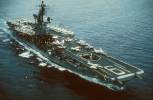 | 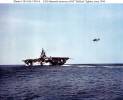 | 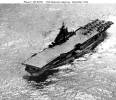 | 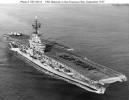 |
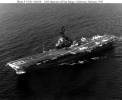 | 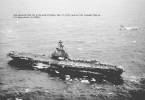 | 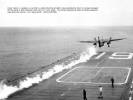 |
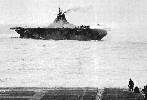
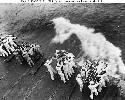
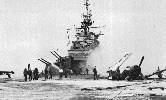
 Back to Carriers list.
Back to Carriers list.